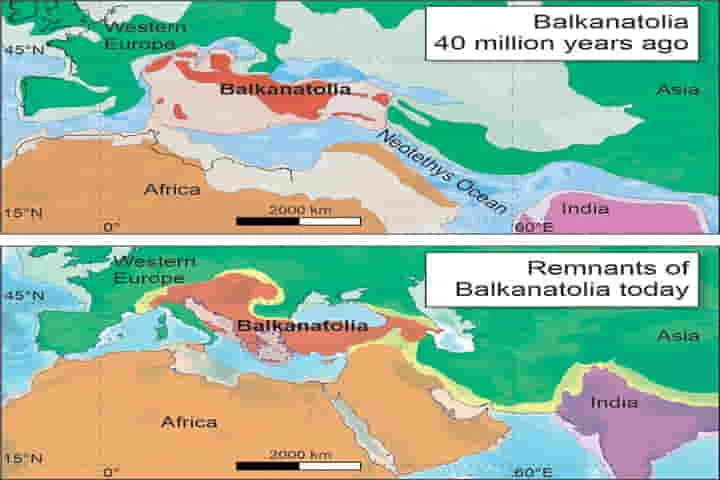

(Top) Balkanatolia, 40 million years ago, and at the present day (Pic. Courtesy sciencealert.com)
<p>
<strong>A low-lying continent 40 million years ago, that was once boasted of some striking animals could have played a vital role in helping Asian mammals to move to Europe&rsquo;s southern part, suggests a new study states a report in sciencealert.com.</strong></p>
<p>
The research published in Earth-Science Reviews refers to this place as &ldquo;Balkanatolia&rdquo; &ndash; placed between Asia, Europe and Africa — which scientists say with the drop in the sea levels, around 34 million years ago, became a land bridge.</p>
<p>
In their study, palaeogeologist Alexis Licht and his colleagues from French National Centre for Scientific Research, mentioned that <a href="https://www.sciencealert.com/a-forgotten-continent-may-have-helped-asian-mammals-colonize-europe-34-million-years-ago?utm_source=ScienceAlert+-+Daily+Email+Updates&amp;utm_campaign=d44c7d0a3d-MAILCHIMP_EMAIL_CAMPAIGN&amp;utm_medium=email&amp;utm_term=0_fe5632fb09-d44c7d0a3d-366100389" rel="nofollow">&quot;When and how the first wave of Asian mammals</a> made it to south-eastern Europe remains poorly understood.&rdquo;</p>
<p>
The appearance of the bridge catalytic as 34 million years ago with the Eocene epoch coming to an end, a vast number of mammals native to Western Europe vanished with new Asian mammals emerging. This unexpected disappearance is called as Grande Coupure.</p>
<p>
However, with fossils discovered recently in the Balkans, the timeline of these events has turned upside down as it points at a region that came into being which facilitated mammals to colonise&nbsp; southeastern Europe almost five to 10 million years before the Grande Coupure happened,.</p>
<p>
In order to look into this, Licht with his associates decided to check evidence that had been found from all known fossil sites in the present-day Balkan peninsula and the Anatolia.</p>
<p>
<strong>Also read: <a href="https://www.indianarrative.com/science-news/million-years-from-now-india-somalia-kenya-and-madagascar-may-merge-into-a-super-continent-141291.html">200 Million Years From Now, India, Somalia, Kenya and Madagascar may merge into a super-Continent</a></strong></p>
<p>
Based on present geological data, the age of these sites was revised. Following this the scientists effected a change in the events that took place in the region in what is best described as a &quot;complex history of episodic drowning and re-emergence&quot;.</p>
<p>
Balkanatolia was remote archipelago nearly 50 million years ago, with no connect with the continents around it. It had distinctive animals which were different from the ones found in Europe and eastern Asia as per the analysis.</p>
<p>
The change in sea levels along with increase in Antarctic ice sheets and tectonic shifts attached Balkanatolia continent with Western Europe and this happened between 40 to 34 million years ago. With this connect taking place, Asian mammals which included four-legged hoofed mammals or ungulates and rodents moved to Balkanatolia. There are fossil records to prove this.</p>
<p>
Besides this, Licht and his associates also found at a fossil site in Turkey jawbone fragments that belong to animal like rhinoceros. This fossil dating back to 38 to 35 million years ago is perhaps the oldest Asian-like ungulate found in Anatolia. It predates the Grande Coupure event by at least 1.5 million years. Thus, one can deduce that the mammals of Asia were moving to Europe through Balkanatolia.</p>
<p>
<strong>Also read: <a href="https://www.indianarrative.com/science-news/australia-s-highly-poisonous-snakes-reached-the-continent-by-sea-study-151391.html">Australia&rsquo;s highly poisonous snakes reached the continent by sea – Study</a></strong></p>
<p>
This route was preferred by animals to the one on higher latitude which went through Central Asia which was then desert steppes, cooler and drier suggested Licht and his associates.</p>
<p>
The team in their paper, however noted that the &quot;past connectivity between individual Balkanatolian islands and the existence of this southern dispersal route remain debated&quot;. They went on to add that what they pieced together &ldquo;is only built on mammalian fossils and a more complete picture of past Balkanatolian biodiversity remains to be drawn&quot;.</p>
<p>
There is a need to study and understand the changes in geological terms that took place to give rise to Balkanatolia. However, unlike fossil record of animals that live on islands which is generally scanty, at Balkanatolia, there is a rich record of terrestrial fossil and as per the team it &quot;provides a unique opportunity to document the evolution and demise of island biotas in deep time&rdquo;.</p>
In the aftermath of the deadly terrorist attack in Pahalgam that killed 26, Michael Rubin,…
India has summoned Pakistan's top diplomat in Delhi, Saad Ahmad Warraich, and handed over the…
The Chinese Foreign Ministry spokesperson Guo Jiakun has condemned the terrorist attack in Jammu and…
The Ministry of External Affairs briefed mediapersons on Wednesday about the slew of measures announced…
Prime Minister Narendra Modi chaired a meeting of the Cabinet Committee on Security (CCS) on…
US Vice President JD Vance on Wednesday called Prime Minister Narendra Modi and strongly condemned…